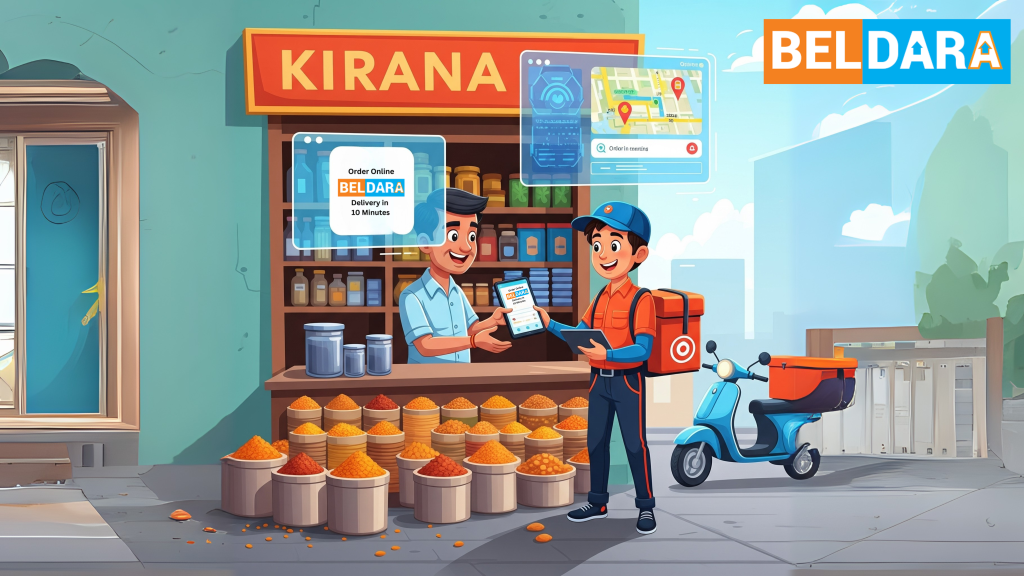
India’s grocery landscape is in the midst of a seismic shift. On one side, we have the timeless Kirana stores — deeply rooted in the culture and functioning as the lifeblood of every neighborhood. On the other, stand new-age 10-minute delivery platforms like Beldara, promising speed, ease, and a digital-first experience.
This isn’t just a battle of old vs new. It’s a fundamental question of coexistence, adaptability, and consumer evolution.
Let’s dive in.
📍 Kiranas: More Than Just Shops
Kirana stores are more than small retailers. They are:
Credit lenders in cash-strapped times.
Friendly faces who know your family’s preferences.
Emergency saviors who are open at odd hours.
Over the decades, Kiranas have built deep trust, community roots, and unparalleled local understanding. Their personalized service and flexibility are unmatched.
🚀 10-Minute Delivery Apps: Redefining Convenience
On the flip side, players like Beldara have introduced a radically different grocery experience:
Seamless app-based ordering
Lightning-fast delivery (under 10 minutes)
Transparent pricing & real-time tracking
Wide product assortment with digital payments
But more than speed, what really makes this model disruptive is predictability and data — Beldara knows what you want, when you want it, and ensures it’s there before you even ask.
⚖️ A Head-to-Head Comparison
- Accessibility
Kirana Store: Walkable, available within local neighborhoods.
10-Minute Delivery Apps (e.g., Beldara): App-based access with doorstep delivery.
- Inventory
Kirana Store: Limited, often based on the shopkeeper’s experience and storage space.
Beldara: Centralized and dynamic, updated in real-time based on demand trends.
- Credit System
Kirana Store: Offers informal credit to trusted customers.
Beldara: Only digital payments; no credit facility.
- Speed
Kirana Store: Instant if you can walk to the store.
Beldara: Delivered within 10 minutes, directly to your home.
- Product Assortment
Kirana Store: Focused on daily essentials and popular items.
Beldara: Offers essentials along with a wide variety of FMCG and packaged products.
- Personal Touch
Kirana Store: High; personal relationships and trust with customers.
Beldara: Lower human touch, but builds personalization through data and app experience.
🤝 Can They Co-Exist?
Yes — but only through collaboration and evolution.
Beldara doesn’t see Kiranas as competitors — in fact, they’re potential partners.
Here’s how Beldara bridges the gap:
✅ Micro Warehousing & Fulfillment Centers: Instead of replacing Kiranas, Beldara builds hyperlocal dark stores or partners with local suppliers for quicker turnarounds.
✅ Data-Driven Demand Forecasting: Using consumption data, Beldara ensures better inventory planning — something many Kiranas struggle with.
✅ Digital Inclusion: Many Kirana owners are being digitally onboarded into quick commerce ecosystems — becoming inventory providers, delivery partners, or click-and-collect hubs.
✅ Empowering the Last Mile: Delivery partners often include individuals from the same communities Kiranas serve — creating jobs and familiarity.
💡 The Future: Hybrid Retail is the Answer
We’re not moving toward the extinction of one model. Instead, we’re headed toward a hybrid future:
Kirana 2.0 — Digitally enabled, app-partnered stores that use real-time inventory and instant delivery platforms.
Beldara’s Vision — Not to wipe out tradition, but to modernize it and make it scalable.
The grocery landscape of tomorrow belongs to those who can offer both speed and soul — and that’s the sweet spot Beldara is aiming for.
🧩 Final Thought
The question isn’t “Who will win?”
It’s “How can we evolve together?”
India’s 1.2 billion+ grocery customers don’t all want the same thing. The key is to build a flexible, inclusive model that respects legacy while embracing innovation.
At Beldara, we’re not just delivering groceries — we’re delivering the future of how India shops.